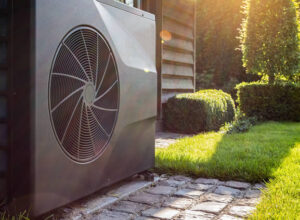How Does a Heat Pump Work:
Harnessing the Power of Nature for Efficient Heating and Cooling

At its core, a heat pump is a device that transfers heat from one place to another. It can extract heat from a cool space and release it into a warm space or vice versa. This ability to move heat against the natural flow of thermal energy is what makes heat pumps so efficient.
To understand the workings of a heat pump, let’s consider a common example: an air-source heat pump, which is widely used for residential and commercial applications. This type of heat pump consists of four main components: an evaporator, a compressor, a condenser, and an expansion valve.
Evaporator:
The process begins with the evaporator, typically located outside the building. The evaporator contains a refrigerant, a substance with excellent heat transfer properties. As the outdoor air passes over the evaporator coils, the refrigerant absorbs heat from the air, causing it to evaporate into a gas.
Compressor:
The now-gaseous refrigerant is then compressed by the compressor, which increases its temperature and pressure. The compressor is the heart of the heat pump, as it provides the energy needed for the refrigerant to circulate and transfer heat effectively.
Condenser:
The high-pressure, high-temperature refrigerant then flows into the condenser, located inside the building. Here, the hot refrigerant transfers its heat to the indoor air, causing it to condense back into a liquid state. This heat exchange process warms up the indoor space.
Expansion Valve:
The condensed liquid refrigerant then passes through an expansion valve, which reduces its pressure and temperature. This prepares the refrigerant to repeat the cycle by returning to the evaporator, where it absorbs more heat from the outdoor air.
The cycle described above continues as long as heating or cooling is required. By extracting heat from the outdoor air during winter and releasing it inside, the heat pump efficiently warms up the building. During summer, the process is reversed, with the heat pump extracting heat from the indoor air and releasing it outside, effectively cooling the space.
One key advantage of heat pumps is that they can provide heating and cooling using the same system, eliminating the need for separate heating and air conditioning units. Additionally, they offer greater energy efficiency compared to traditional heating systems, such as furnaces or electric resistance heaters. Heat pumps achieve this efficiency by transferring heat rather than generating it, making them significantly more environmentally friendly and cost-effective in the long run.
Another significant benefit of heat pumps is their ability to leverage renewable energy sources. Geothermal heat pumps, for example, utilize the stable temperatures of the earth to extract or release heat. This geothermal energy can be tapped into through underground pipes, known as ground loops, which transfer heat between the earth and the heat pump. By utilizing this renewable resource, geothermal heat pumps can provide efficient heating and cooling throughout the year.
In conclusion, heat pumps are highly efficient and sustainable devices that utilize the principles of heat transfer to provide heating and cooling. By extracting heat from one place and releasing it into another, they offer reliable climate control while minimizing energy consumption and greenhouse gas emissions. Whether it’s an air-source heat pump or a geothermal heat pump, this technology showcases how we can harness the power of nature for a greener and more comfortable future.


